You know what you want to achieve, yet the results aren’t showing. Why? Maybe you’re not getting the results you’re after because your decisions aren’t taking you to where you want to go. Here are ten suggestions that can help you make better decisions.
Find your inner calm
Emotional stress interferes with how you process the information in your surroundings; if you’re panicking or stressed, your intellectual and intuitive intelligences are impaired. Your emotions overthrow your decision-making, and you end up in damage-control mode, trying to repair the negative consequences of poorly conceived decisions. Therefore, the number-one way to improve your decision-making is to regulate your emotions.
Know when to follow plans and when to co-create
In emergencies, plans are essential to coordinate expertise and effort so that everyone knows what to do within the chaos. But when work is constantly chaotic, plans can be hazardous. Why? Quite simply because, in those conditions, you need to be creative rather than fixed.
Plans work in situations where the circumstances are predictable. In business, the key is to apply the right approach to the circumstance. Predictable market conditions favor plans. Unpredictable market conditions favor co-creation.
Keep your mind nimble
How you think informs the actions you take. Concrete thinkers prefer to deal with the tangibles and consider ideas and concepts impractical. Conceptual thinkers work with ideas and concepts but tend to overlook the details. Blend the two, and you’ve got a lovely combination.
Different kinds of thinking apply to differ kinds of circumstances, and you can’t successfully move from operational to strategic or senior-level decision-making without adjusting your thought and decision-making processes.
Focus on the mission
In decision-making, focus dictates where your attention goes. If you pay attention to the wrong things, you make poor decisions. For example, if you focus on meeting the budget solely by instituting cost-cutting measures and ignoring your customers, pretty soon you won’t have any revenue at all (customers are optional, after all!).
Therefore, be alert to what you’re paying attention to. Doing so helps you stay centered on what’s important in achieving your overall goals and ensures that you’ve thought through the consequences of your decisions.
Innovate through disruption
Use surprises to reinvent the company. For example, when revenues are falling, employee disengagement is high, and nothing you’re doing or have previously relied on works, don’t resist change or deny inconvenient truths — a strategy that can take you out of the game completely.
Instead, acknowledge that an impending shift to market or business conditions is occurring and use the gap between what you think should be happening and what actually is happening to do things differently.
It takes only one idea to inject newness into routine attitudes and raise results to a higher level of achievement. Act on the simmering sense that it’s time to take a radically different approach.
Tap into your intuition
Instant decision-making takes place in milliseconds and draws, without your conscious awareness, on the vast stash of solutions, decisions, and experiences you’ve built up over time. The best way to strengthen the range of solutions your brain subconsciously taps into is to make a lot of decisions. If you feel confident in your current setting, great! Then change to a dissimilar environment so that you can develop experiences in a new setting.
Learn from mistakes
Check the newspapers, and you’ll find stories that show many ways companies can make mistakes. It’s the best way to see, without incurring the expense of making the mistake yourself, how decisions can fail to consider consequences or assess risk.
In studying mistakes, try to learn what happened: Where in the decision-making process did the error occur, and why did it occur? Study other companies’ successes and failures to observe what they missed in the decision-making process. When you learn from mistakes — whether they involve your own, your company’s, or others’ misfortunes — you can apply the lessons to your own decision-making.
Keep an open mind
Keeping an open mind allows you to incorporate instead of reject new information because it’s unfamiliar or seems irrelevant. Being open to new information allows you to stay current and make better decisions because you’re not ignoring how your customers or employees feel or what they need.
Balance the intuitive with the rational
Intuition is slippery, has been known to fail, and can’t be measured. No wonder decision-makers prefer to trust something more specific and precise, like rational thinking.
But here’s a little secret: Rational decision-making really isn’t that rational. Things other than logic play into just about every decision you make, whether you know it or not. (Think of the number of senior decision-makers who make decisions that serve personal gain over company goals.)
Your intuitive intelligence anticipates events before they occur. When you tap into it, you can process volumes of information in a nanosecond, simultaneously holding the short and long term in your mind without blowing any brain fuses. Intuitive and rational processes each bring unique strengths to the decision-making process.
Pay attention to the workplace
Interpersonal relationships and unwritten rules in the workplace combine with the given circumstances to produce the conditions for decision-making. How things get done, the degree of autonomy employees have, their commitment to their peers, the accountability people have for the decisions they make, and so on, all impact the resilience and durability of decision outcomes.
Workplace design is part of the formula for faster response time and more accurate decisions. Removing barriers to real-time information exchange accelerates rapid, more accurate responses. Creating workplaces and working relationships that support employees improves their ability to make sound judgments and good decisions.
Review your workplace to ensure that it supports the health and wellness of your employees. Offering places for rest and reflection can revitalize the workplace, reduce stress, reduce cost, and increase employee retention.

